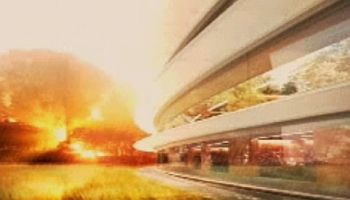Jobs’ Apple Doughnut Has Green Aspirations

Apple’s next headquarters may look like a fattening doughnut but it will be lean and green, Steve Jobs maintains
The plans for Apple’s next headquarters building in Cupertino, California, will have several green features.
The circular outer building will enclose a courtyard which will provide shade and privacy for the workforce. According to the plan, the three million square foot sphere will house 12,000 staff, which could mean a quadrupling of the current headcount by 2015.
A Ring Of Green Confidence
 The doughnut shape also means that more glass can be incorporated in the three-storey building. This will allow the company to take advantage of the California sunshine and save on electric lighting. It could also mean a healthier life for the employees because studies claim that well-lit workspaces, using natural light, result in 50 percent fewer sick days and greater productivity.
The doughnut shape also means that more glass can be incorporated in the three-storey building. This will allow the company to take advantage of the California sunshine and save on electric lighting. It could also mean a healthier life for the employees because studies claim that well-lit workspaces, using natural light, result in 50 percent fewer sick days and greater productivity.
The downside is that there will be a need for good air conditioning, and a way to reduce the harsh sunlight which could trigger migraines and cause glare on workstation screens. Ihab Elzeyadi, associate professor of architecture and director of the High Performance Environments Lab at University of Oregon has also cast doubts on the building’s benefits, particularly the courtyard.
“Once the courtyard becomes so large and over-proportioned, you lose the bio-climatic benefits of a courtyard-centred building in creating a microclimate that is different from the unprotected space,” Elzeyai said.
Power For The People

Although energy consumption for the thousands of computers housed in the HQ will probably be less than today’s models, the air-conditioning load will have to be addressed. Jobs said Apple would provide this from its own “energy centre” using Cupertino’s electric supply as a backup if the alternative power fails.
Jobs has not said how the energy will be generated, but the design of the site leaves plenty of room for solar energy cells. Apart from festooning the building with panels, the 60 percent increase in green space for the site would allow room for a sizeable energy farm.
The extra green space is being provided by sinking the company car park under the new structure, leaving just a few parking spaces above ground for short stay traffic, such as visitors. This leaves room for the planting of 6,000 trees and an apricot orchard.